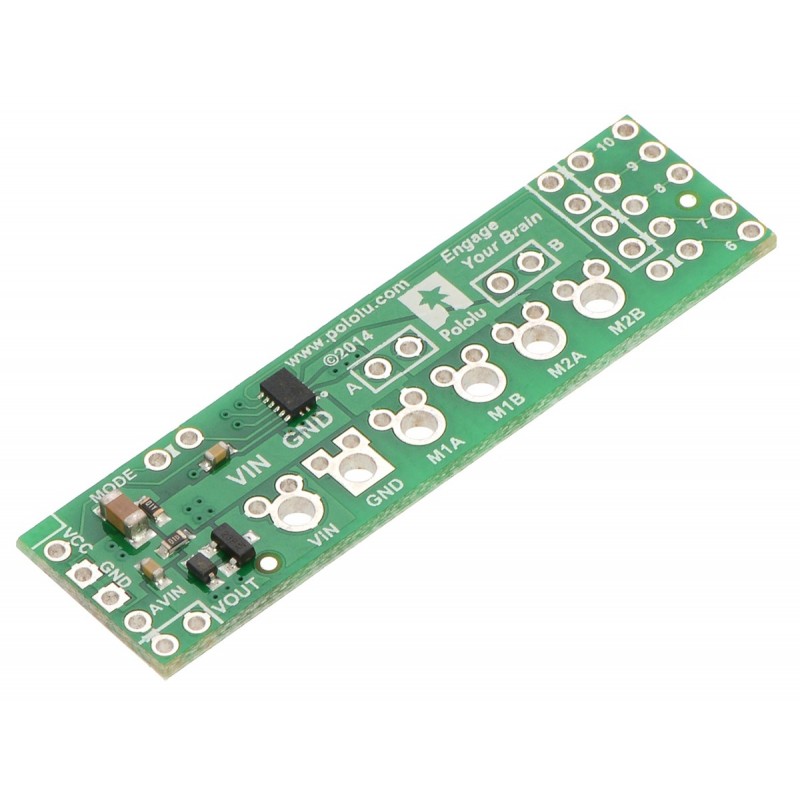










33,57 zł Netto
Niewielki, wydajny i ekonomiczny shield do Arduino, idealny do małych silników DC i projektów o niskim napięciu. Oferuje elastyczne tryby sterowania, solidne zabezpieczenia i opcję zwiększenia prądu przez zrównoleglenie kanałów. Świetny wybór do robotyki amatorskiej i edukacji. Pololu 2511
Kompaktowy shield do Arduino umożliwiający sterowanie dwoma szczotkowymi silnikami DC (lub jednym o podwyższonym prądzie). Wykorzystuje układ DRV8835 (podwójny mostek H), przystosowany do niskich napięć i małych silników. Dzięki gotowej bibliotece Arduino oraz prostemu okablowaniu sprawdzi się w robotach, projektach edukacyjnych i prototypach mechatronicznych.
Uwaga: płytka Arduino nie jest dołączona
Cechy
Producent BTC Korporacja sp. z o. o. Lwowska 5 05-120 Legionowo Polska sprzedaz@kamami.pl 22 767 36 20
Osoba odpowiedzialna BTC Korporacja sp. z o. o. Lwowska 5 05-120 Legionowo Polska sprzedaz@kamami.pl 22 767 36 20
Moduł rozszerzeń do budowy drukarki 3D lub maszyny CNC. Przeznaczony do współpracy z Arduino Mega i sterownikami silników krokowych A4988
Brak towaru
Sterownik silników DC, który pozwala na kontrolowanie ruchu trzech napędów za pomocą interfejsu I2C. W zestawie płytka ze złączami do montażu. Pololu 5069
Moduł z 2-kanałowym sterownikiem silników DC do płytek Arduino. Pozwala na sterowanie napędami o napięciu zasilania od 6 do 32 V i poborze prądu do 0,65 A. Pololu 2512
Dual MAX14870 Motor Driver to podwójny sterownik silników DC kompatybilny ze standardem Arduino pozwalający na wysterowanie dwóch silników DC napięciem 4,5-36V prądem ciągłym 1,7A. Pololu 2519
Moduł zawiera dwa sterowniki silników L293D oraz rejestr przesuwny 74HC595. Rejestr przesuwny rozszerza 3 linie Arduino do 8 linii, co pozwala na sterowanie kierunkiem pracy silników. Wyjście L293D jest bezpośrednio sterowane wyjściami PWM Arduino
Rozszerzenie typu shield dla Arduino ze sterownikiem PWM 16-kanałowym, 12-bitowym pozwalającym na równoczesne sterowanie 16 serwomechanizmami za pomocą interfejsu I2C. Adafruit 1411
Brak towaru
Sterownik silników DC, który pozwala na kontrolowanie ruchu trzech napędów za pomocą interfejsu I2C. W zestawie płytka bez złączy. Pololu 5070
Quad DC Motor Driver Shield to sterownik silników DC kompatybilny z Arduino, który pozwala na sterowanie 4 silnikami DC napięciem w zakresie 2,5...13,5V i prądem do 1,2A. DFRobot DRI0039
Adafruit Motorshield to shield umożliwiający łatwe sterowanie silnikami DC, krokowymi oraz serwomechanizmami przy pomocy Arduino. Zawiera sterowniki silników DC, krokowych oraz wyjścia do sterowania serwomechanizmami. Umożliwia adresowanie oraz łączenie ekspanderów (do 32) i sterowanie przy pomocy jednej płytki Arduino. Adafruit 1438
Pololu Dual G2 High-Power Motor Driver 24v14 to rozszerzenie pozwalające na sterowanie dwoma silnikami prądu stałego przeznaczone dla płytek Arduino. Silniki mogą być zasilane napięciem 6,5...40V i pobierać maksymalnie prąd o natężeniu do 14A. Pololu 2516
Sterownik silników DC, który pozwala na kontrolowanie ruchu dwóch napędów za pomocą interfejsu I2C. Płytka ze złączami do montażu. Pololu 5040
Brak towaru
X-NUCLEO-IHM02A1 to moduł sterownika dwóch silników krokowych oparty na dwóch układach L6470. Poziom logiczny 3,3 lub 5 V, sterowanie przez SPI. Złącza zgodne z Arduino i STM32 Nucleo
Sterownik silników DC, który pozwala na kontrolowanie ruchu dwóch napędów za pomocą interfejsu I2C. Płytka bez złączy. Pololu 5038
Brak towaru
X-NUCLEO-IHM15A1 to płytka rozszerzeń z podwójnym sterownikiem silników DC zasilanym napięciem w zakresie 7...45V o maksymalnym prądzie wyjściowym 1,5A na każdym z kanałów. Kompatybilny z STM32 Nucleo. X-NUCLEO-IHM15A1
Sterownik silników DC, który pozwala na kontrolowanie ruchu trzech napędów za pomocą interfejsu I2C. W zestawie płytka bez złączy. Pololu 5032
Brak towaru
Dwukanałowy sterownik silników elektrycznych (mostek H) Arduino Motor Shield Rev3 z układem L298 do sterowania dwóch silników DC lub jednego silnka krokowego z możliwością użycia hamulca elektronicznego. Arduino A000079
Brak towaru

Niewielki, wydajny i ekonomiczny shield do Arduino, idealny do małych silników DC i projektów o niskim napięciu. Oferuje elastyczne tryby sterowania, solidne zabezpieczenia i opcję zwiększenia prądu przez zrównoleglenie kanałów. Świetny wybór do robotyki amatorskiej i edukacji. Pololu 2511
